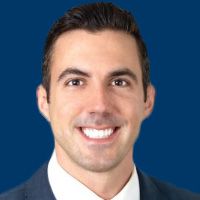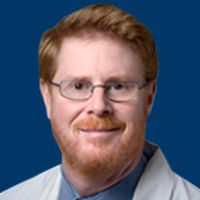Vogel Provides Insights on Advanced HCC Management and Expanding Immunotherapy Combinations
Arndt Vogel, MD, discusses the importance of multidisciplinary tumor boards in navigating the treatment arsenal in advanced hepatocellular carcinoma.
Arndt Vogel, MD

Recent advancements in the treatment paradigm and understanding of advanced unresectable hepatocellular carcinoma (HCC) underscore the importance of multidisciplinary tumor boards in guiding therapeutic decisions, as phase 3 trials such as HIMALAYA (NCT03298451) and the ongoing IMbrave152 (NCT05904886)study explore and introduce immunotherapy combinations beyond standard atezolizumab (Tecentriq) plus bevacizumab (Avastin), according to Arndt Vogel, MD.
“The [definition and treatment] of advanced HCC has changed. [Treatment selection] depends on local experience, and these patients should only be treated in centers that have a multidisciplinary tumor board at least to discuss their options,” said Vogel, who is a professor of medicine at the University of Toronto and a clinician scientist in the University Health Network, at the Toronto Centre for Liver Disease.
In an interview with OncLive®, Vogel discussed how the evolving definition of advanced unresectable HCC necessitates the use of multidisciplinary tumor boards during treatment selection; highlighted ongoing efforts to identify clinically useful biomarkers in HCC despite a lack of success; and discussed the potential expansion of bevacizumab-based immunotherapy combinations into earlier HCC stages.
Vogel also serves as the Longo Family Chair in Liver Cancer Research in the Division of Gastroenterology and Hepatology at Toronto General Hospital/Princess Margaret Cancer Center in Canada.
OncLive: What are some of the primary considerations when selecting a treatment regimen for patients with advanced unresectable HCC?
Vogel: The question is how do we define advanced unresectable HCC? It’s [clear] that [these] patients are not good candidates for resection or transplantation, but the [definition] of advanced is changing. In the past, we considered advanced disease as Barcelona Clinic Liver Cancer [BCLC] stage [C] and [D], so patients with extrahepatic metastases or vascular [invasion]. We consider these patients [to be candidates] for systemic therapies today. In BCLC intermediate-stage HCC, we would consider systemic therapy. We are more critical about the use of local therapies, including when to use what, and when to switch from local to systemic therapy. To decide what the best treatment option for a patient is, we need to [consult a] multidisciplinary tumor board with teams from surgery, interventional radiology, hepatology, [and] oncology. [They can also inform whether] we should use local or systemic therapy, or, considering the recent MRI data, [if these approaches] should be combined. The [patient’s] tumor burden, number [of] sites for comorbidity, liver function, and overall treatment goals [therefore] need to be discussed in the interdisciplinary tumor board.
How have data from the HIMALAYA trial of Single Tremelimumab-actl (Imjudo) Regular Interval Durvalumab (Imfinzi; STRIDE) affected your use of atezolizumab and bevacizumab?
It depends on the reimbursement time point. In Germany, we had the STRIDE regimen available for a longer period, whereas here in Canada we are just now able to use it. It’s good to have options. We also have the TKIs sorafenib [Nexavar] and lenvatinib [Lenvima]. With multiple options in the first-line setting, we can adjust the treatment to the patient’s profile. We don’t have clear molecular or clinical biomarkers to indicate [which specific treatment] a patient should get, but all the different regimens have different adverse effect [AE] profiles and risk profiles. Having these options, which include the STRIDE regimen, offers us more flexibility. [Atezolizumab and bevacizumab] is probably the standard of care at most centers, but the use of other drugs, specifically STRIDE, will increase in the near future.
What might be seen with the addition of tiragolumab to bevacizumab and atezolizumab in the IMbrave152 study? Could these data potentially sway providers to use the triplet instead of the doublet?
We have seen early data [reported with this combination from the phase 1b/2 MORPHEUS-liver trial (NCT04524871)] recently. This was a small trial, and the control arm did not perform as we would have expected. Therefore, it’s a little bit difficult to understand the value of the triplet compared with the doublet. Overall, the trial indicates that a subgroup of patients might benefit from the triplet vs the doublet. From a safety profile [standpoint administration of the triplet] is feasible. [However], I’m not sure that the data [suggest that this regimen is] the next breakthrough. It could advance the field if we would be able to find a biomarker. These data are most likely sufficient to proceed to a phase 3 study to understand the value of the triplet compared with the doublet.
Is there any ongoing or planned biomarker research to better identify patients with HCC who may benefit from these regimens?
There is a great interest in biomarkers. In the past, we used to diagnose patients mainly by using imaging. Today, it’s more [common] that we also do a tissue biopsy, so we will have more data available on not only clinical markers, but also molecular markers. We talked about atezolizumab and bevacizumab, and it’s still interesting to see the benefit of [adding] bevacizumab to immunotherapy. We have now seen this not only in the adjuvant intermediate [stage], but also in the advanced stage. [Harnessing] the VEGF pathway seems to be important to increase the efficacy of checkpoint inhibitors. For the [IMbrave150] study [NCT03434379], there was an extensive analysis of potential clinical and molecular markers published in Nature Medicine. That was a very interesting analysis, but it confirmed that it’s difficult to find a biomarker [of response]. Of course, if you have higher immune cell infiltration, we would expect more efficacy, which was confirmed. However, we still do not have a biomarker to really select our treatment. This is something that we will look at in the near future. Multiple academic centers and pharmaceutical companies are interested in finding [actionable] biomarkers.
What is your advice for community oncologists who may not have access to these multidisciplinary tumor boards?
I would advise them to at least send the patients to a center that has a multidisciplinary tumor board to evaluate all options. In HCC, that is critical, because the options we have [include] surgery, interventional radiology, stereotactic body radiation therapy, radiation, systemic therapy, and transplantation.
As research with immuno-oncology combinations continues to expand into earlier HCC settings, what is the importance of weighing all meaningful end points in discussions about clinical trial results?
We are now seeing immuno-oncology [IO] combinations moving from the advanced stage to earlier stages and adjuvant, intermediate stages. In all stages, we have seen their use [expanding]. It’s good to see the efficacy of these IO-based combinations, but we also learned that we need to discuss [other meaningful] trial end points. Different end points have been used, [including] recurrence-free survival and progression-free survival [PFS]. In the end, we always come back to the discussion of overall survival [OS] and then are a bit disappointed if we do not see an OS benefit. However, we need to be sure that what we use as our primary end point for clinical trials [is clinically meaningful].
This is an oversimplification of the situation because one primary end point cannot cover everything. We need to see the totality of the data, which includes safety and toxicity, AE profiles, quality of life, [and] secondary end points. [Additionally, any] trends for OS, [including] the median and the hazard ratio will be important. [Ultimately], we need to be sure of what we would consider clinically meaningful beyond the primary end point, because we will always discuss the primary end point [regardless].
How might the role of bevacizumab continue to evolve as it is investigated in combination with immunotherapy in earlier lines? Are there any concerns about the loss of efficacy for patients who receive such regimens in the adjuvant setting and later experience progression?
Bevacizumab was investigated many years ago as monotherapy. There were some signals of efficacy [with the agent], but nothing convincing, [along with] signs of toxicity with bleeding events. In the beginning, bevacizumab alone never made it into the clinic. Now with the [bevacizumab and] IO combinations, we have seen a lot of positive, phase 3 studies [showing a] clinically meaningful benefit, so there’s something about bevacizumab in combination with checkpoint inhibitors. Nevertheless, there’s also toxicity related to the treatment. Even if we can manage most of the AEs, this is something we need to take into account when we think about its use in very early stages.
The other point you mentioned is also very important. What does it mean to use bevacizumab and IO combinations in the early setting, and how does it affect subsequent treatment? This is something we need to understand. We need to see more follow-up data from [clinical studies], but also real-world evidence to see how this will affect OS. Even if the primary end point is PFS, we need to also see [the regimen’s] long-term impact [and identify if] at least a subgroup of patients can survive longer. [This is especially important], as we do not really have good biomarkers to identify whether those patients truly can have long-term benefit.



